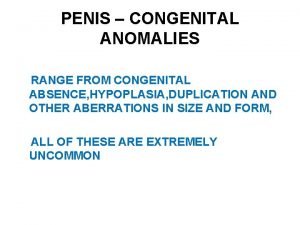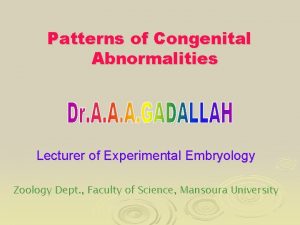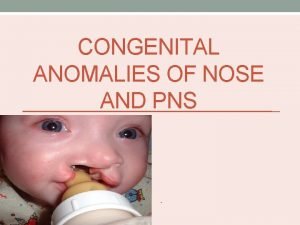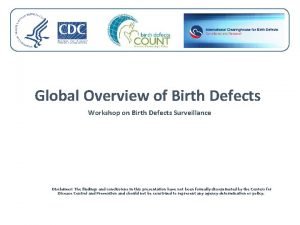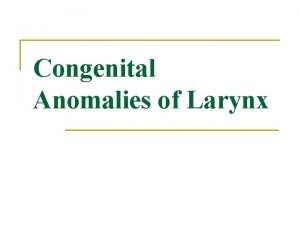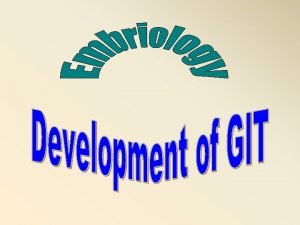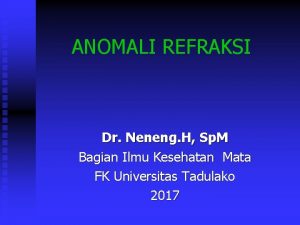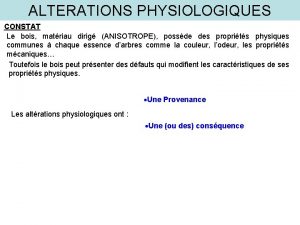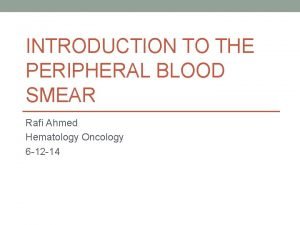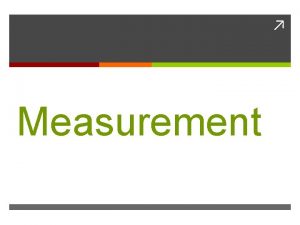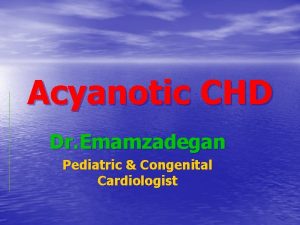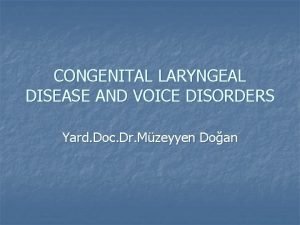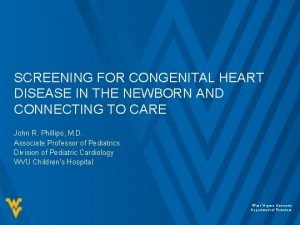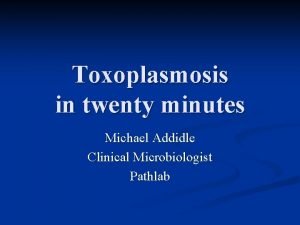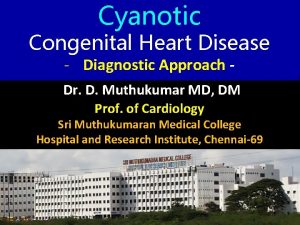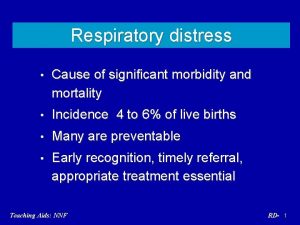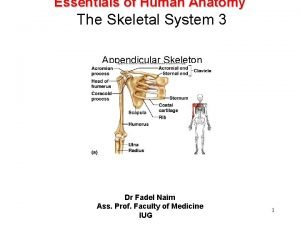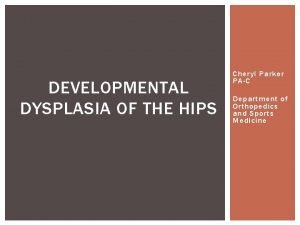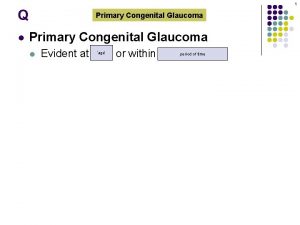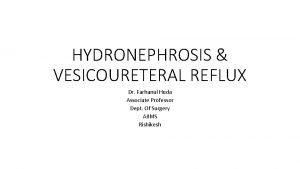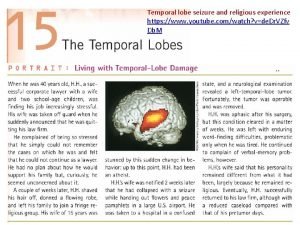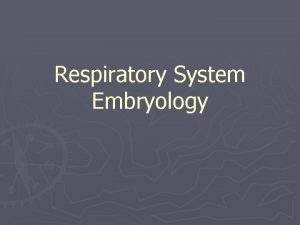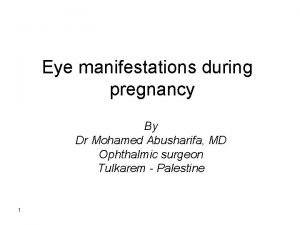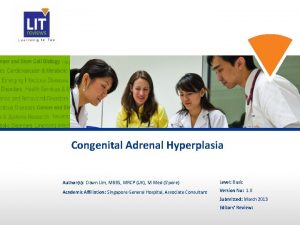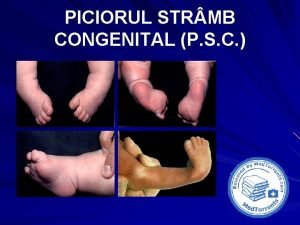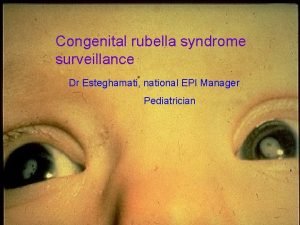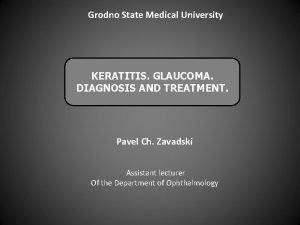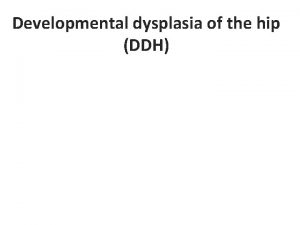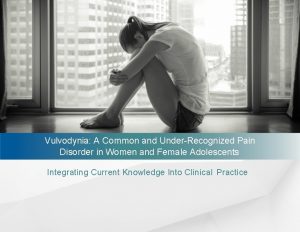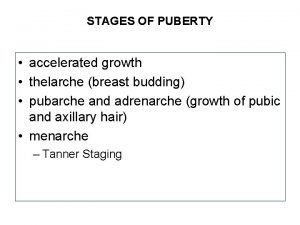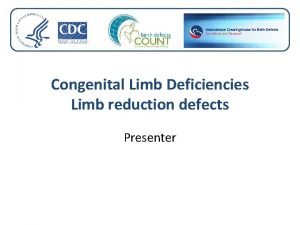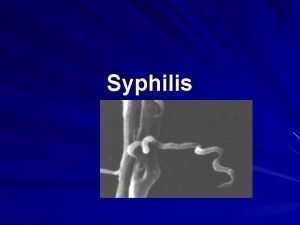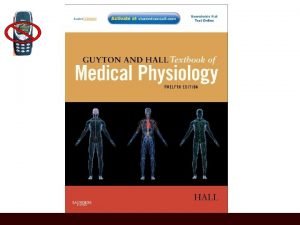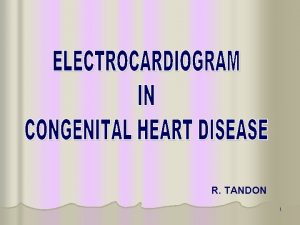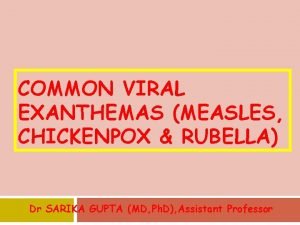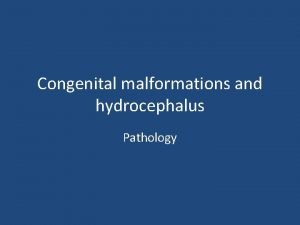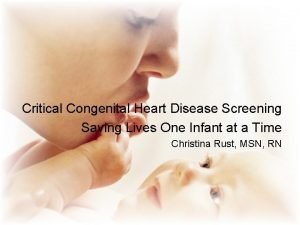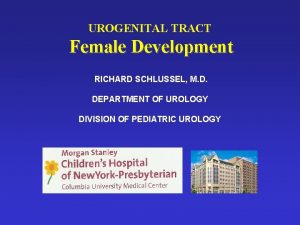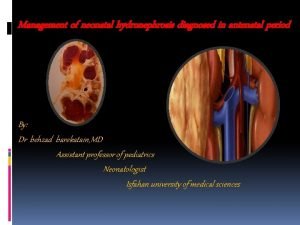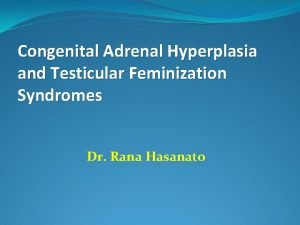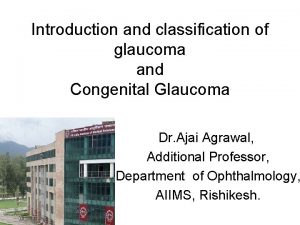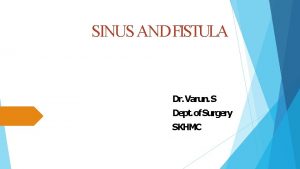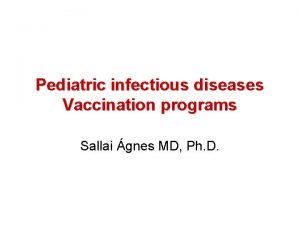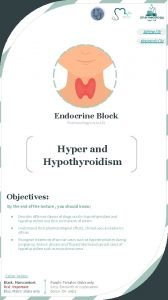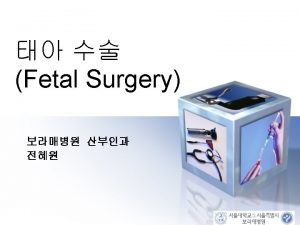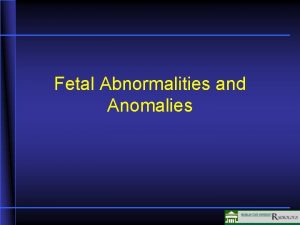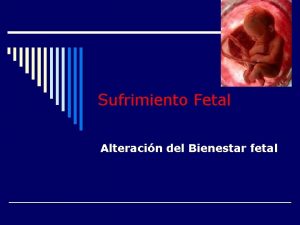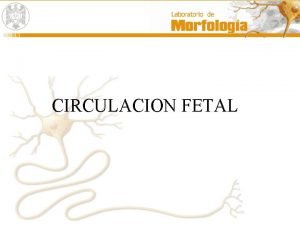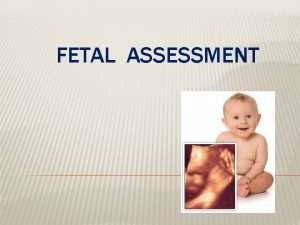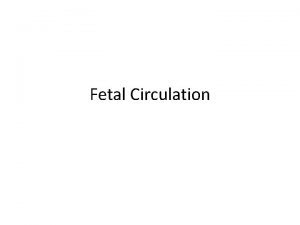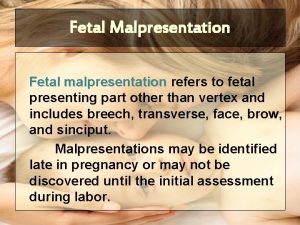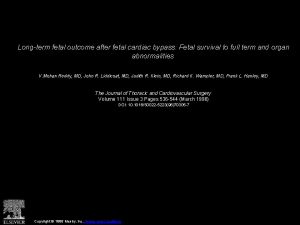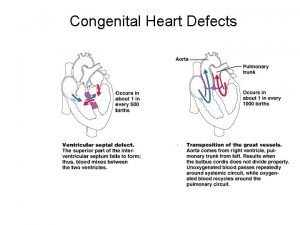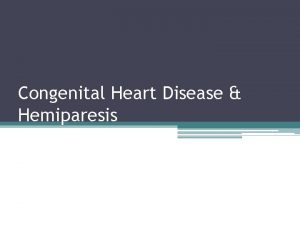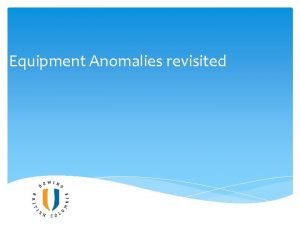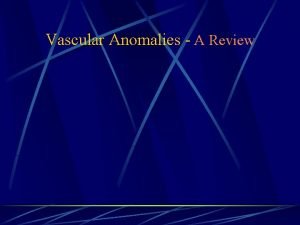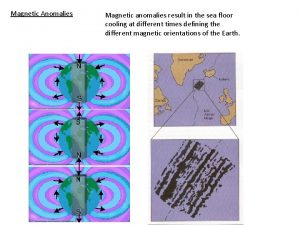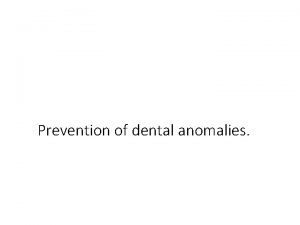CONGENITAL FETAL ANOMALIES 1 Terminology Congenital means exist






































































- Slides: 70

CONGENITAL FETAL ANOMALIES 1

Terminology Congenital means exist since birth, whether clinical evidences are obvious or not obvious. Anomaly means a deviation from the normal. Malformation means faulty development of a structure 2

Types of congenital anomalies: Physical structural defects: Single structure is affected. Multiple structures are affected. Non-structural defects Inherited metabolic defects Functional and behavioral deficits e. g. congenital mental retardation. 3 Incidence: Major congenital anomalies: affects about 2 to 5% of all newborns. Minor anomalies occur in higher percentage of newborn (about 10%). The risk of recurrence of congenital malformations with the same patient is very important in genetic counseling. Most of congenital anomalies are single primary developmental anomaly general empirical average figure of 2 to 5%, to the apparently known healthy parents with one affected child. More accurate figures could be calculated only when the etiology is due to a defect in a single gene and according to the laws of inheritance e. g. hemophilia

Etiology of Congenital Anomalies Unknown cause (60%): The causes of malformations are not identifiable in the majority of cases. Multifactorial factors (20%): Multifactorial etiology denotes the presence of an interaction between genetic predisposition and non-genetic intrauterine factors. Common examples include neural tube defects, certain forms of hydrocephaly, facial clefts, cardiac anomalies, and imperforate anus. 4

Genetic basis: Thousands of known genetic diseases that may affect humans as all inherited disorders Are passed from one generation to another. Genetic diseases may be secondary to either of the following: Secondary to a single mutant genes (7. 5%): ‘Mendelian single gene disorders’ that carries a risk of causing congenital malformations. – Autosomal dominant and recessive disorders: » – 5 About 3000 disorders are inherited in humans due to single gene disorder. e. g Hemoglobinopathies. sickle cell disease, thalassemia&Renal disorders: polycystic kidney disease. Sex chromosomal traits (X-linked diseases): There is no male transmission e. g. hemophilia, muscular dystrophy.

Secondary to chromosomal anomalies (6%). 6 Abnormality of chromosome number (numerical abnormalities): » Triplicate number of portion or an entire chromosome: clinically - Autosomal abnormalities: e. g. Trisomies e. g. trisomy 21, 18 and 13. Trisomy 13 and 18 are fatal. - Sex chromosome anomalies: The most common are Turner’s syndrome (45, X), Kleinfelter’s syndrome (47, XXY). » Monosomies: Single number of chromosome: monosomy X. e. g. X-linked mental retardation (fragile X syndrome). Abnormality of chromosome structure: Deletions, translocations, inversions.

Exogenous influences Teratogen exposures : Teratogenesis mostly occurs before the tenth week of intrauterine life (the period of embryogenesis). Extrinsic insults: Intrinsic insults: – Maternal infections: rubella virus, cytomegalovirus, toxoplasmosa gondi, human parovirus B 19 infection, and syphilis. – Noninfectious systemic e. g. diabetes mellitus, phenylketonuria, and seizure disorders. – Functional virilizing lesions of the ovary and adrenal glands. 7 Environmental agents: – organic solvents, pesticides, anesthetic gases and heavy metals like lead, lithium, and organic mercury. Drug exposure and medications: – Examples of known human teratogenic medications: » Hormonal agents: Progesterone , androgenic hormones causing masculinization of the female fetus and thyroid antithyroid drugs. » Thalidomide causing phocomelia and other limb congenital malformations. Physical injury: Exposure to high doses of ionizing radiation produces gene mutation, chromosomal aberrations and abnormalities.

The Food and Drug Administration “FDA” lists five categories of tabling for drug use in pregnancy A. B. C. D. X. 8 Controlled studies in women failed to demonstrate a risk to the fetus in the first trimester, and the possibility of fetal harm appears remote. Animal studies do not indicate a risk to the fetus, there are no controlled human studies, or animal studies do show an adverse effect on the fetus, but well –controlled studies in pregnant women have failed to demonstrate a risk to the fetus. Studies have shown the drug to have animal teratogenecity or embryocidal affects, but no controlled studies are available in either animals or women. Positive evidence of human fetal risk exists, but benefits in certain situations (e. g. , serious diseases for which safer drugs are ineffective) may make use of the drug acceptable despite its risks. Studies in animals or humans have demonstrated fetal anomalies and the risk clearly outweighs any possible benefit.

9

Prevention Of Having An Offspring With Congenital Anomalies Pre-Pregnancy assessment General Guidelines Antenatal Diagnosis Postnatal Assessment 10

I. General guidelines: Control of medications during pregnancy: Minimize drug exposure. Detection and control of relevant maternal diseases. Genetic counseling. Prenatal diagnosis of genetic conditions and selective termination of the affected pregnancy or in-utero treatment if possible. Discourage consanguineous marriages when appropriate e. g. closed family, previous inheritable malformation in the family. 11

Pre-Pregnancy Assessment Genetic counseling: A pre-pregnancy information given to couples with family history of congenital and inherited disorders, helping them to make a decision regarding future childbearing. The correct advice provides accurate information concerning the recurrence risks. General screening programs: The aim is to identify some of the common genetic disorders in a community. – 12 Adult screening programs in selected high-risk groups: » Common examples of autosomal recessive disorders: sickle cell anemia, thalassemia major. » Gravidas over 35 years: Cytogenic studies on fetal cells obtained by amniocentesis or chorionic villus sampling. » Neonatal screening programs: Some of the disorders that are in needs for immediate identification after delivery and to be screened soon after delivery are phenylketonuria, congenital hypothyroidism, sickle cell disease and galactosemia.

Pre-natal Diagnostic Procedures History Taking Abnormal findings during routine examination Abnormal findings during routine investigations Specific Antenatal diagnostic procedures 13

History Taking leading questions of special significance: Maternal age. Personal or family history of congenital anomalies e. g. familial disorders in the blood relatives. The ethnic origin. Significant maternal diseases: diabetes mellitus, infections, and acute maternal illness. 14

Suspicious Findings On Clinical Examination A higher incidence of congenital anomalies are detected in association with : Oligohydramnious: – renal dysplasia, renal agenesis, – bladder outlet obstruction and – intrauterine growth retardation. Polyhydramnios: – Central nervous system anomalies: anencephaly, hydrocephaly. – Gastrointestinal malformations: Tracheoesophageal fistula, duodenal atresia. 15 Threatened abortion. Unexplained IUGR.

Suspicious Findings On Routine Investigations Suspicious findings on ultrasound screening: Early IUGR Oligohydramnios Hydramnios Restricted fetal movements 16

Abnormal maternal serum alpha-fetoprotein (MSAFP) MSAFP is elevated (2. 5 MOM) –Fetal anomalies such as neural tube defects, abdominal wall defects e. g. omphalocele, esophageal or intestinal obstruction, cystic hygroma, urinary obstruction, renal anomalies: polycystic kidneys, osteogenesis imperfecta, Turner’s syndrome, and Rh disease. –Obstetrical complications such as low birth weight, oligohydramnios, multifetal gestation. MSAFP is abnormally low (<0. 2 MOM) –Chromosomal trisomies of the fetus. The values are low in only one third of Down’s syndrome, –Gestational trophoblastic disease, and fetal death. The triple test: 17 –Specified combinations of maternal serum assay of AFP, unconjugated oestriol (u. E 3) and h. CG. Special tables are used to interpret the results.

18

Specific Prenatal Techniques Non-invasive techniques: Malformation ultrasound scan 2 D Vs 3 D and 4 D scans MRI. Invasive techniques: Amniocentesis Chorionic villous sampling (CVS), Cordocentesis, Fetoscopy Tapping of fluid filled fetal structure e. g. collection of fetal urine for assessment of the renal function. 19

Anomaly Scans Structural Assessment: Systematic documentation of the essential fetal anatomy: head, neck, chest, abdomen, limbs, external genitalia, Assessment of amniotic fluid volume. The umbilical cord and its vessels. Measurements are calculated (Biometry): The most significant measurements are BPD (biparietal diameter), OFD (occipto-frontal diameter), HC (head circumference), and femur length. Serial measurements are used to evaluate the growth pattern of organs. 20

21

22

Amniocentesis It is the most frequently and the established invasive procedure to be performed. The samples contain: Fetal somatic cells that can identify the cytogenetic constitution of the fetus. Fluid that can be used to assess variety of biochemical processes. Indications of amniocentesis Chromosomal abnormality, open neural tube defect, inborn error of metabolism. 23

40 ml 12 weeks 24 100 ml 185 ml 14 weeks 16 weeks

25

26

Problems • Fetal Loss • Failed Amino. • Culture Failure 27 0. 5% 1. 0% 0. 5%

Chorionic Villous Sampling (CVS) The aim is to obtain chorionic cells (fetal in origin) for laboratory study. Advantages of (CVS) over amniocentesis: Fetal cells could be obtained at an earlier gestational age. Lengthy culture procedures are unnecessary, as chorion cells divide very rapidly. – A decision for termination, if necessary, could be taken at an earlier stage of pregnancy with greater safety and less legal and religious concerns. 28

29

Needle Chorionic Tissue 30

CVS - Complications Fetal loss ~1% Unsuccessful CVS 1 – 5% (Depends on operator experience and accessibility of placenta) Ambiguous results/maternal cell contamination ~1 -2% Culture failure 1 -2% 31

Factors Affecting Rate of Fetal Loss Following CVS Experience of operator Number of attempts Time of sampling Manipulation required Route of CVS Who Report 1991 32

Percutaneous Umbilical Cord Blood Sampling ‘Cordocentesis’ The aim is to obtain fetal blood, using ultrasound directed needling of the umbilical cord. The needle is directed to enter an umbilical vessel at the cord root. Possible indications of cordocentesis: Diagnostic: Fetal karyotype. Other blood tests: Coagulation factors, hemoglobin composition, blood cells and platelets, Respiratory gases. Cases with isoimmunization: Fetal blood type and Rh status, coombs antibody testing, complete blood cell count 33 Therapeutic: Transfusion of compatible donor blood. Fetal Loss in ~1% of the cases.

Laboratory Investigative Procedures Chromosome analysis: simple cytogenic techniques special culture and examination for minor chromosome aberrations Biochemical analysis: Bilirubin in rhesus isoimmunization: normally it is excreted in fetal urine. Microvillar enzymes from the fetal gut for cystic fibrosis. Alpha-fetoprotein: nearly all of AFP is fetal in origin. 34

Laboratory Investigative Procedures DNA analysis: Polymerase chain reaction (PCR) – Chorionic villi. – Amniotic fluid or fetal blood. Molecular genetics is the study of the structure of the genes. Its value in the obstetric practice is related to the study of inherited disease. Fetal Gender Determination risk of a serious X-linked hereditary disorders, for which no specific prenatal diagnostic test is readily available. The aim is termination of pregnancy if the fetus is of the exposed type of the Xlinked disorder. Fetal infection Testing either the amniotic fluid or the chorionic villi or fetal blood. Testing for possible fetal viral infection is indicated in cases of maternal virus infection. Hematological analysis: haemoglobinopathies, coagulation disorders, and fetal blood grouping 35

What to Do when a CFA is Discovered? Counseling Termination of pregnancy: Cultural background and religious beliefs play a role in the decision, Indicated with malformations incompatible with life to e. g. anencephaly, and multiple malformations with poor prognosis. 36

What to Do when a CFA is Discovered? Counseling Prenatal therapy or surgery, available for few conditions only: Medical treatment: Intrauterine heart failure and supraventricular arrhythmia’s: – maternal medication of digoxin and propranolol. Congenital adrenal hyperplasia: – dexamethasone to the mother to reduces accumulation of androgenic steroids and to lessens virilization of female fetus. Surgical treatment: Isoimmune anemias: (e. g. due to Rhesus disease) In utero treatment by intravascular or intraperitoneal transfusion. Obstructive hydrocephalus: attempts at intrauterine ventriculo -amniotic shunts are being tested. Urinary tract obstruction: implanting a catheter from the fetal bladder to the amniotic cavity. Gene therapy: still experimental. 37

What to Do when a CFA is Discovered? Counseling Planning the best circumstances for delivery. Congenital anomalies requiring urgent surgical procedures and special care after delivery: Gastrointestinal tract obstruction: pyloric stenosis, esophageal atresia, intestinal atresia, duodenal atresia, jejuno-ileal atresia, colonic atresia, ano-rectal malformations. Urinary tract obstruction. Congenital diaphragmatic hernia. Exomphalos and extrophy (bladder cloaca). Open neural tube defects. Congenital adrenal hyperplasia. 38

Postnatal Diagnosis Of Congenital Fetal Malformations Many cases of congenital malformation, even in the current obstetric practice are detected only after delivery. Routine examination of all newborns immediately after birth and few days later is essential component in the routine practice. 39

Some Congenital Fetal Anomalies of the Nervous System Anomalies of the GIT Anomalies of the Genito-urinary Tract Cardiovascular Anomalies Anterior Abdominal wall defects Diaphragmatic hernia Down’s Syndrome Non Immune Hydrops Fetalis 40

Prevention of CNS Anomalies Correction of dietary habits: Certain dietary patterns are deficient in folic acid, and need to be modified. Peri-conceptional folate administration. Peri-conceptional control of DM Special tests during pregnancy in highrisk individuals for early detection of such anomalies. 41

Anencephaly is a lethal anomaly due to the absence of The membrane-ossifying bones of the cranial vault and consequently the skull and scalp. The cerebral hemispheres, underlying the above structures It is more common in girls. Antenatal diagnosis: Clinical features: Polyhydramnios and abdominal palpation (absence of head). Investigations: – Raised plasma and amniotic fluid -fetoprotein levels and – ultrasound features. Management of anencephalic pregnancy: 42 Elective abortion. Vaginal delivery : there is an increased incidence of face presentation and shoulder dystocia

43

Hydrocephalus is an excess of cerebrospinal fluid within the ventricles, and the subarachnoid space. 44 Congenital cerebral malformations: e. g. Arnold-Chiari malformation. Congenital fetal infections e. g. toxoplasmosis, cytomegalovirus. Intrauterine intracranial hemorrhage. Certain forms are multifactorial origin. Obstruction of the aqueduct of Sylvius which may be due to genetic disorders as trisomy 21, infection as toxoplasmosis and cytomegalovirus, intracranial tumors, and intracerebral hemorrhage. Chromosomal abnormalities: triploidy, trisomy 18, and X-linked trait.

Antenatal diagnosis of hydrocephalus: Clinical: – – Polyhydramnios. Large size head. Breech presentation is common During labor, vaginal examination: Wide sutures, large fontanelles and thin, soft identable cranial bones. Ultrasound: – Diagnostic value: serial ultrasound studies are important to avoid false positive diagnosis. – Prognostic value: » the type of hydrocephalus » the site and extent of the brain injury » The cerebral cortex compression is followed regularly. Congenital hydrocephalus is commonly associated with other neurological or general congenital malformations e. g. spina bifida, harelip, clubfoot, or imperforate anus. 45

Management Options Termination of pregnancy could be offered, if diagnosis is definite in the early second trimester. Search for associated anomalies. Establishment of the etiology if possible. Amniocentesis to determine fetal karyotype. Intrauterine therapy (under ultrasound guide): Attempts at intrauterine ventriculo-amniotic shunts (with a one way valve may be done to drain CSF from cerebral ventricles into the amniotic sac to prevent compression and atrophy of brain tissues) are being tested. 46

Management Options Effects of hydrocephaly on vaginal delivery: Breech presentation is common. Feto-pelvic disproportion: Non-engagement of the presenting large head and obstructed labor. Some infants cannot be delivered without destructive procedure or cesarean section. Conduct of delivery: Destructive procedures to facilitate vaginal delivery. The head is perforated and cerebrospinal fluid is drawn off. In breech presentation, the aftercoming head is either perforated or spinal tapping is carried out. A metal canula is introduced through the spinal canal (or through spina bifida is present). Delivery of a live newborn, with possible cesarean section, when there are favorable signs. 47 Absence of associated anomalies. Stable hydrocephalus. Cerebral mantel remains more than 10 mm (thickness of cerebral cortex) and the newborn will have surgical procedures after delivery i. e. shunting operations (ventriculo-peritoneal shunt).

Microcephaly is an abnormally small head. Diagnosis depends on biometry: Occipto-frontal diameter (OFD) and BPD are reduced. Complications of microcephalus: Mental retardation: the smaller the head the worse the prognosis. The presence of associated anomalies 48

Spina bifida and Meningomyelocele Spina bifida is a defect in the spine resulting from failure of the two halves of the vertebral arch to fuse. Ultrasound features of spina bifida: – The features appear by 18 -20 weeks gestation in about 90 per cent of cases. – The posterior ossification centers of the spine, at the level of the defect are widely spaced. The vertebral segment appears in U-shape. The defect may be visualized on longitudinal scanning. – There is restricted motility of the lower limbs 49

50

The prognosis is related to the following: – Presence and severity of neurological involvement – The presence of associated abnormalities: e. g. » Arnold-Chiari malformation (coexisting hydrocephalus due to prolapse of the cerebellar hemispheres (obstructing the flow of CSF). It is to be noted that 90 per cent of cases of spina bifida have or develops hydrocephalus later on. » Orthopedic malformations: congenital dislocation of hips, foot deformity e. g. talipes, and kyphoscoliosis. 51 » Chromosomal defects: e. g. trisomy 18.

Types: Spina bifida occulta: The bone only is affected, while the spinal cord and the membranes are intact. There may be a patch of hairy skin or a dimple over the affected area. It has a good prognosis. No treatment is required. Spina bifida cystica ‘ overta’which includes: » Meningocele. It is protrusion and herniation of the meninges, through a bony deficit to the skin. » Meningomyelocele: It is a protrusion of heterotopic neural tissue with the meninges. The defect is in the midline and affects the skin of the back, muscles, bones of the vertebral arches and neural tube. The membrane is easily ruptured » Myelocele: No skin or meninges to cover the lesion. It is usually incompatible with life. Immediate care after delivery: 52 Cover the lesion with a sterile non-adhesive dressing to minimize trauma and infection. Search for associated malformations Consult a neurosurgeon.

Anterior Abdominal Wall Defects The defect in closure may involve the lower part of abdominal wall only, or bladder, urethra and penis, and/or clitoris and labia. These are associated with increased MSAFP. Unfortunately high percentage of cases have an associated cardiac and chromosome abnormalities. 53

Types: Omphalocele (exomphalos): Congenital herniation of some of the intra-abdominal contents through the umbilical ring. DD. Gastroschisis – Hernia of the umbilical cord Ectopia vesicae: the defect involves the bladder. [Exstrophy of bladder: The trigone and urethral orifices are exposed] Management of defects of the anterior abdominal wall: Immediate care: Do not clamp protruding mass. Clamp the umbilical cord few centimeters distal to the swelling. Keep the hernial sac moist and warm, using pads soaked in a normal saline solution. Protect from irritation, traumatic injury of covering membrane or organs and from infection. Empty the stomach of air with a nasogastric tube. Surgical corrective repair. 54

55

Gastrointestinal Tract Anomalies The prognosis is generally good after surgical correction [provided NO other anomalies co-exist] Malformations presenting with intestinal obstruction: Bowel obstruction above the ileum. All usually results in polyhydramnios due to failure of absorption of swallowed amniotic fluid. After delivery there is vomiting and abdominal distension. Surgery at early neonatal life is successful in duodenal atresia, esophageal atresia, pyloric stenosis, jejeunal and ileal atresia. Bowel obstruction below the ileum. Generalized distention of bowel loops on ultrasound The causes are: – 56 – – – Dysfunctional: the distention may be transient and resolve spontaneously. Meconium ileus. Anal atresia and imperforate anus. Hirschsprung’s disease

57

Cleft Lip and Cleft Palate Several teratogens may cause either of the two conditions. Generally both are not associated with other gastrointestinal malformations. Cleft Lip: It is cleft in the upper lip. It may be unilateral or bilateral. a small notch in the vermilion to a complete separation extending into the of the nose. There may be feeding problems. It is often associated with floor cleft palate. Surgical repair can be done in the first few days of life. Cleft Palate: Bifid uvula. A cleft on midline uvula. Cleft soft palate. Cleft bony palate. Gap in the alveolar arch. Feeding problems may develop e. g. aspiration and infection. Corrective surgery: best results if performed around one year of age. Postoperative complications: are not rare. 58 – – Recurrent otitis media. Speech and hearing problems.

Urogenital System Abnormalities Renal Agenesis: It is a rare abnormality. It is fatal when bilateral. Potter’s syndrome: – – – Renal agenesis, pulmonary hypoplasia, oligohydramnios, IUGR, characteristic compressed facial features, flattened nose, small chin, prominent epicanthal folds and with a low-set ears. At birth there is severe respiratory problems. Ultrasonic confirmation is difficult because it is based on the documentation of the absence of the renal echoes, in severe oligohydramnios. Also perirenal fat or adrenal glands may mimic the renal shadow. Obstructive uropathy: Various causes of obstruction to urinary flow. Ultrasound diagnosis: Enlarged bladder and/or hydronephrosis. The condition may be unilateral or bilateral. Features after delivery: abdominal mass because of enlarged bladder and/or hydronephrosis. Types: – Pelviureteric junction obstruction is considered as acute rather than chronic obstruction. The prognosis is favorable. Posterior urethral valves: occur in male. They are responsible to varying degrees of dilatation of the renal tract. Complete urethral stenosis: complete absence of amniotic fluid and gross dilatation of the renal tract. Kidneys may be subjected to severe dysplasia, and appears small with increased echogenicity 59

Anomalies of the external genitalia Chromosomal anomalies. Adrenal cortical hyperplasia. Maternal intake of adrenogenic substances. Undescended Testicles Preterm When to correct Epispadius/Hypospadius Associated with XXY, Trisomy 18 60

Cardiac Anomalies Some are minor self-limiting or easily correctable defects, while some are serious and can be lethal. The common lesions are ventricular septal defects, patent ductus arteriosus, atrial septal defect, pulmonary stenosis, fallot’s tetralogy. Associated extra-cardiac lesions are present in 30 % of cases. Ultrasound examination of the fetal chest: Four-chamber view of the heart: View at right angles to the longitudinal aspect of the fetal spine. That view demonstrates arrhythmias. M-mode tracings of different cardiac chambers or structures. Doppler color-flow mapping. To define the pattern of the blood flow. Fetal Echocardiography 61

Single umbilical artery May be a single anomaly Possible associated malformations Esophageal atresia, Imperforate anus, Trisomy 18 syndrome. 62

Diaphragmatic Hernia Pulmonary hypoplasia is a common serious associated anomaly. Chromosomal anomalies are commonly encountered Antenatal diagnosis by ultrasound (cystic spaces within the chest). Presentation at birth: Respiratory distress, scaphoid abdomen, displaced apex beat. Radiological examination: intrathoracic bowel shadows 63

Hydrops Fetalis Hydrops fetalis is excessive fluid accumulation within the fetal soft tissues (tissue edema) and body cavities (effusions). Ultrasound features of full blown hydrops: Increased skin thickening: > 5 mm. Placental thickening: > 4 cm. Body cavities: Significant pleural and pericardial effusions and ascites. 64

Hydrops Fetalis Causes of fetal hydrops: Immune hydrops fetalis. Due to chronic intrauterine anemia. The well-known example is Rh isoimmunization. Non-immune hydrops fetalis: Generally it has a high incidence of mortality. 65 Fetal cardiac arrhythmias e. g. supraventricular tachycardia. Due to heart failure. Fetal structural cardiac anomalies e. g. hypoplastic left heart, due to heart failure. Pulmonary hypoplasia Renal dysplasia. Hypoproteinaemia Congenital nephrosis. Intrauterine infections: due to chronic intrauterine anemia e. g. toxoplasmosis, rubella, cytomegalovirus infections, congenital hepatitis, parvovirus infection. Chromosomal abnormalities: e. g. Turner’s syndrome, trisomy 18 or 21. Congenital hematological disorders: e. g. thalaaemia. Twin-to-twin transfusion.

Down’s syndrome It is Trisomy 21 syndrome. Incidence: general incidence is 1: 600. The incidence rises with increase of maternal age. – 1: 365 at 36 years and 1: 40 at the age of 40 years Neonatal features: Head: Flat face and flat occiput, third fontanelle, upward slanted palpebral fissure, inner epicanthal folds and simply formed ears, nose: small, flat nasal bridge, mouth: small and the tongue protrudes. Neck: short, broad. Loose folds in posterior neck. Hands: simian single palmar crease, short metacarpals and phalanges. Hypotonia. Short humerus and femur Heart: High incidence of cardiac defects e. g. artrioventricular canal defect. Increased incidence of leukemias Gastrointestinal: Duodenal atresia, Hirschsprung’s disease. 66

Antenatal Diagnosis First trimester Increased Nuchal Thickness PAPP-A Failure to detect the nasal bone 67

When the nasal bone line appears as a thin line, less echogenic than the overlying skin, it suggests that the nasal bone is not yet ossified, and it is therefore classified as being absent [ 11 -13+6 weeks] 68

Second Trimester Screening The Triple Test The Quad Test Triple Test + Dimeric Inhibin A (DIA) Integrated first and Second Trimester Screening Diagnostic procedures MUST involve genetic testing of samples obtained from the baby 69

70
 Erythroplasia of queyrat
Erythroplasia of queyrat Kode icd palatoschisis
Kode icd palatoschisis Micrognathia definition
Micrognathia definition Mcgovern nipple
Mcgovern nipple Birth defects causes
Birth defects causes Congenial
Congenial Irregularities in population pyramids
Irregularities in population pyramids Andrea frazzini aqr
Andrea frazzini aqr Attention anomalies
Attention anomalies Anomalies du rcf pendant le travail
Anomalies du rcf pendant le travail Database anomalies
Database anomalies Data redundancy and update anomalies
Data redundancy and update anomalies Anomalies du rcf pendant le travail
Anomalies du rcf pendant le travail Ferri
Ferri Oddball: spotting anomalies in weighted graphs
Oddball: spotting anomalies in weighted graphs Enterocystoma
Enterocystoma Cfsv2 monthly prec anomalies
Cfsv2 monthly prec anomalies Accommodation anomalies
Accommodation anomalies Anisotrope bois
Anisotrope bois Modification anomalies
Modification anomalies Rbc anomalies
Rbc anomalies Internet terminology
Internet terminology Meta means change and morph means heat
Meta means change and morph means heat Bio means life and diversity means
Bio means life and diversity means Poly means many and gon means
Poly means many and gon means Life bio
Life bio Morphe means in metamorphism
Morphe means in metamorphism Canadian congenital heart alliance
Canadian congenital heart alliance Congenital cardiologist near me
Congenital cardiologist near me Congenital voice disorders
Congenital voice disorders Congenital
Congenital Farah garmany
Farah garmany Michael addidle
Michael addidle Congenital fibrosis of the extraocular muscles
Congenital fibrosis of the extraocular muscles Eisenmenger syndrome
Eisenmenger syndrome Congenital
Congenital Congenital pneumonia
Congenital pneumonia Surgical neck
Surgical neck Congenital dislocation of hips
Congenital dislocation of hips Congenital glaucoma
Congenital glaucoma Vesicoureteral reflux
Vesicoureteral reflux Congenital rubella syndrome triad
Congenital rubella syndrome triad Hypothyroidism
Hypothyroidism Congenital amusia
Congenital amusia Congenital diaphragmatic hernia
Congenital diaphragmatic hernia Congenital toxoplasmosis
Congenital toxoplasmosis Congenital adrenal hyperplasia electrolytes
Congenital adrenal hyperplasia electrolytes Codivila
Codivila Congenital rubella syndrome
Congenital rubella syndrome Congenital glaucoma
Congenital glaucoma Rosen view
Rosen view Vulvodynia
Vulvodynia Congenital adrenal hyperplasia characteristics
Congenital adrenal hyperplasia characteristics Congenital limb deficiency
Congenital limb deficiency Tetralogy of fallot xray
Tetralogy of fallot xray Background
Background Mineralocorticoid function
Mineralocorticoid function Congenital heart
Congenital heart Choledocolithaisis
Choledocolithaisis Congenital rubella syndrome triad
Congenital rubella syndrome triad Congenital malformations
Congenital malformations Congenital heart defect
Congenital heart defect Hymen
Hymen Congenital hydronephrosis
Congenital hydronephrosis Congenital adrenal hyperplasia characteristics
Congenital adrenal hyperplasia characteristics Egg on a string heart
Egg on a string heart Trabeculodysgenesis meaning
Trabeculodysgenesis meaning Fistula vs sinus
Fistula vs sinus Ttn vs rds cxr
Ttn vs rds cxr Congenital rubella
Congenital rubella Potencity
Potencity
